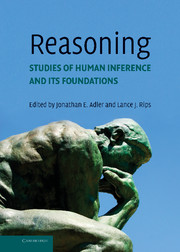Book contents
- Frontmatter
- Contents
- Preface
- List of Contributors
- Introduction: Philosophical Foundations
- PART I FOUNDATIONS OF REASONING
- PART II MODES OF REASONING
- PART II INTERACTIONS OF REASONING IN HUMAN THOUGHT
- Section 9 Reasoning and Pragmatics
- Section 10 Domain-Specific, Goal-Based, and Evolutionary Approaches
- Section 11 Reasoning and Cultures
- Section 12 Biology, Emotions, and Reasoning
- 51 Logic and Biology: Emotional Inference and Emotions in Reasoning
- 52 Distinct Brain Loci in Deductive versus Probabilistic Reasoning
- 53 The Emotional Dog and Its Rational Tail: A Social Intuitionist Approach to Moral Judgment
- Index
- References
53 - The Emotional Dog and Its Rational Tail: A Social Intuitionist Approach to Moral Judgment
Published online by Cambridge University Press: 05 June 2012
- Frontmatter
- Contents
- Preface
- List of Contributors
- Introduction: Philosophical Foundations
- PART I FOUNDATIONS OF REASONING
- PART II MODES OF REASONING
- PART II INTERACTIONS OF REASONING IN HUMAN THOUGHT
- Section 9 Reasoning and Pragmatics
- Section 10 Domain-Specific, Goal-Based, and Evolutionary Approaches
- Section 11 Reasoning and Cultures
- Section 12 Biology, Emotions, and Reasoning
- 51 Logic and Biology: Emotional Inference and Emotions in Reasoning
- 52 Distinct Brain Loci in Deductive versus Probabilistic Reasoning
- 53 The Emotional Dog and Its Rational Tail: A Social Intuitionist Approach to Moral Judgment
- Index
- References
Summary
Julie and Mark are brother and sister. They are traveling together in France on summer vacation from college. One night they are staying alone in a cabin near the beach. They decide that it would be interesting and fun if they tried making love. At the very least it would be a new experience for each of them. Julie was already taking birth control pills, but Mark uses a condom too, just to be safe. They both enjoy making love, but they decide not to do it again. They keep that night as a special secret, which makes them feel even closer to each other. What do you think about that? Was it OK for them to make love?
Most people who hear the above story immediately say that it was wrong for the siblings to make love, and they then begin searching for reasons (Haidt, Bjorklund, & Murphy, 2000). They point out the dangers of inbreeding, only to remember that Julie and Mark used two forms of birth control. They argue that Julie and Mark will be hurt, perhaps emotionally, even though the story makes it clear that no harm befell them. Eventually, many people say something like, “I don't know, I can't explain it, I just know it's wrong.” But what model of moral judgment allows a person to know that something is wrong without knowing why?
- Type
- Chapter
- Information
- ReasoningStudies of Human Inference and its Foundations, pp. 1024 - 1052Publisher: Cambridge University PressPrint publication year: 2008
References
- 16
- Cited by



